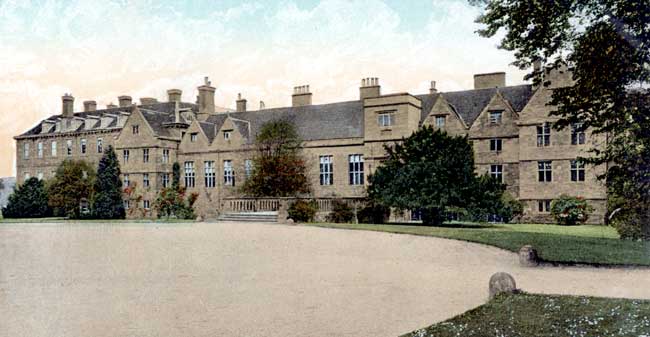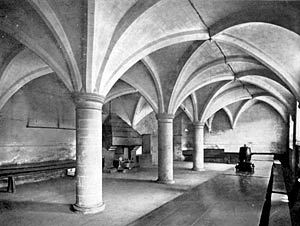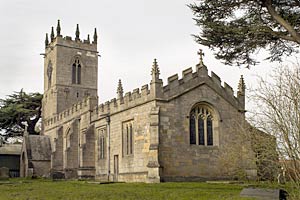< Previous | Contents | Next >
One of the Saddest Figures in History

Rufford Abbey, c.1910.
RUFFORD ABBEY. Two miles from Ollerton, it is a charming neighbour of the ducal homes of Notts, a piece of Tudor England with many additions which have only added to its beauty. Its fate, like that of many great English homes, is in the balance as we write, but it stands as a noble structure and its story lives on.

The vaulted undercroft at Rufford Abbey in the 1930s.
The story goes back to the middle of the 12th century, when Gilbert de Gaunt founded an abbey here. The vaulted refectory is now the servants' hall, almost all that is left of the ancient place which, at the Dissolution, was granted to the Earl of Shrewsbury. It was his daughter-in-law (Bess of Hardwick) who built the Elizabethan house, and it was the marriage of a grand-daughter that brought Rufford to the Saviles, with whom it remained till 1938.
Among its treasures were beautiful tapestries and fine portraits. One is Van Dyck's portrait of Lord Strafford, who stayed at the abbey when the Marquis of Halifax (one of the fickle ministers of James the Second) was a boy; Strafford wrote him letters on the follies of Court life. It was Lord Halifax who added the Stuart wing to the house, where his brother Henry, a famous diplomat, was born in 1642.
It was in the chapel here in 1574 that the Earl of Lennox married Elizabeth Cavendish, Bess of Hardwick's daughter, the only child of the marriage being Arabella Stuart, whose portrait hangs in the drawing-room.
One of the saddest figures in history, Arabella Stuart was born in 1575, daughter of the Earl of Lennox, brother of Lord Darnley, and was next in succession to the throne after James the First.
She was early the centre of plots to set her on the throne in place of Elizabeth who, though sometimes speaking of her as her successor, imprisoned her. At the accession of her cousin James, Arabella's partisans urged that she, being British born, had a better right to the throne. A plot at the time aimed at the deposition of James and the crowning of Arabella, who was entirely innocent of complicity. The only offence the luckless princess committed was (in 1610) in secretly marrying William Seymour, a descendant of the Tudors. She was 35, he 13 years younger, and they desired only to be left alone; but James, roused to jealous fears, sent Seymour to the Tower and banished Arabella to Durham. She escaped disguised as a man, took ship for France, while Seymour escaped from the Tower and followed in another ship. A storm kept the ships apart, and Arabella was captured off Calais and brought back to England.
Arabella languished for four years a prisoner in the Tower, guiltless of all crime. First her health, and next her reason failed, and in 1615 she died, a melancholy ruin. Her husband remained in France until after her death, when he returned to England, fought as a Royalist, and at the Restoration was made Duke of Somerset. Arabella lies in Westminster Abbey, in the tomb of her aunt, Mary Queen of Scots.
The gardens of the abbey, set in a deer park of over 500 acres with a lake (filled by Rainworth Water), are very beautiful. The house is seen at the head of a lime avenue leading from handsome entrance gates, on the highway. In the park itself once stood a shelter in which William Mompesson lived when he came to Eakring as rector. Over three years had passed since he had seen his folk at Eyam die one by one from plague, refusing to leave the village lest they should spread it to the outer world; but the inhabitants were still fearful that the brave parson would bring the plague to them, and Mompesson took refuge in the park.
Enshrined in Trees

Saundby church in 2013.
© Copyright J.Hannan-Briggs and licensed for reuse under this Creative Commons Licence
SAUNDBY. Three miles from Gainsborough and half as far from the Trent, it is charming with its few cottages and farms, its big house, and the church, all mantled in trees. Some of the finest trees grow in the churchyard, reached by way of the buildings and haystacks of the Manor Farm; one magnificent cedar has a trunk 16 feet round and branches making a circle of 80 yards, and another has lost the great arms which reached too near the chancel. They are worthy companions of a gracious church much rebuilt in the last half century.
The tower, with eight pinnacles, is 15th century; the nave arcade of two bays is 13th, and separated from it by seven feet of wall is a 700-year-old arch leading to the chapel. The beautiful font with a band of diamond pattern on the bowl comes from the close of Norman days, and a medieval piscina, elaborate with pinnacles and a finial, has a head carved on the projecting drain. The altar table is Elizabethan, and a Bible of 1611 has a leather cover with tiny flowers engraved on its metal bosses and clasp.
One of the windows has St Martin giving half of his cloak to a beggar at the gate of Amiens; in another he is asleep and dreaming, seeing in a vision Our Lord wearing the other half of the cloak. In a medley of old fragments in the tower are the small figure of a woman and the tiny face of a man. The screens, the roofs, and the door with splendid hinges letting us in, are good craftsmanship of our own day.
A battered stone knights of the 14th century lies in the nave, wearing armour and a helmet; his feet are gone, but the lion on which they rested is still here. There is a floorstone with a brass inscription to William Saundeby, who made the church new before he died in 1418, and a canopied monument is to John Helwys, lord of the manor till the end of the next century.
